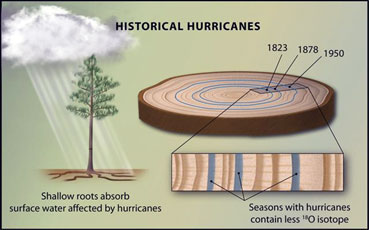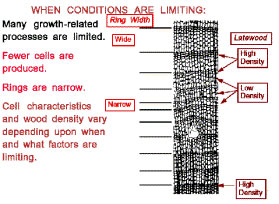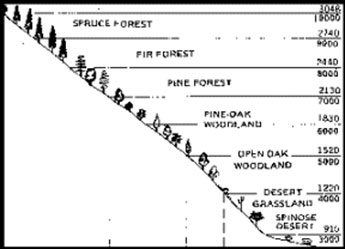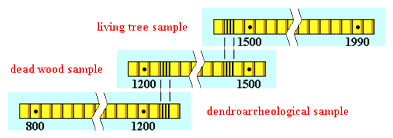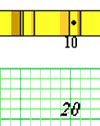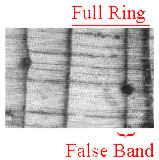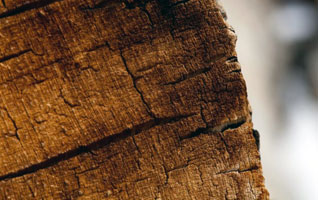Geology and Natural Heritage of the Long Valley Caldera
Dendrochronology and the Bristle Cone Pines
Hansford Mann
Abstract
This paper explores dendrochronology and how the Great Basin bristlecone pine contributes to the study. Within the work various methods of dendrochronology are explained and related directly to other topics in the paper. In this paper we observe the Principles of Dendrochronology, how we can study past climates, and the significance of the bristlecone pine. Resources used in this paper include a number of web related sources and other sources from scientific journals.
dendochronology and the bristle cone pines
Since man ignited his first fire our species has contributed to the change in our natural climate and like the ancients we still don’t really know what’s going on. Until the early nineteenth century there were very few researchers and even fewer with substantial knowledge on our climate. Joseph Fourier determined, based on the size of our planet and its distance from the Sun, that Earth should be much colder if we only received heat from the Sun’s radiation. Within his works published in 1824 he considered the possibility of our atmosphere acting as an insulated shell keeping heat trapped in, however, this was not his final conclusion to the problem (O’Connor and Robertson 1997). The point is, we’ve just started to scratch the surface when it comes to changes in our climate; up until the nineteenth century there has been no scientific understanding in how our climate works. Despite our knowledge base we have come a long way in two hundred years and the methods we use to conduct research have greatly improved. Some of the ways we observe changes in our climate come from things like weather stations, balloons, and satellites at a computer-based level. We use methods like ice coring, sediment analysis, and tree ring observation for physical evidence (United States Environmental Protection Agency 2014).
Using trees to answer questions about our natural world and humanity’s impact on our environment, termed dendrochronology, is one of the best ways to observe climate change’s effect on organisms and correlates in most cases with geological evidence (Laboratory of Tree-Ring Research 2012). In the Sierra Nevada and surrounding area dendrochronology is a very useful method for interpreting past environmental conditions. For example, trees like the giant sequoias and bristlecone pines are great to observe on account of their age. As a science, the study of tree rings can be used in many different ways but the applications have similar goals. The past, present, and future environmental conditions have a wide scope of interest especially in the active Sierra Nevada environment (Laboratory of Tree-Ring Research 2012).
The Sierra Nevada mountain range is located between the Central Valley of California and the Basin and Range Provence, most of the range is within California’s state lines. The Range of Light runs about 640 kilometers north to south and 110 kilometers across. The Sierra’s distinct character is shaped by its remarkable ecology and geology. Over a 100 million years before present the granite that composes most of the range was formed deep underground. About four million years before present the Sierra started to uplift and with the combination of glacial erosion the granite was exposed making up the light-colored landforms that make up this area.
The White Mountains, home of the Great Basin Bristlecone Pine, are a part of a triangular fault block that directly faces the Eastern Sierra Nevada across the Owens Valley. The range runs 97 kilometers; they have the average width of 32 kilometers. The White Mountains share many similarities with the other mountain ranges on the Eastern edge of the Basin and Range Province; they have a high elevation and are arid. They contain Bristlecone pines on the permeable dolomite and granite substrates; another species, the Limber pine, grows on the other rocky substrates. In the lower elevations Utah juniper and Pinon pine are dominant.
In 1964, the Forest Service gave access to a few parts of the Great Basin Bristlecone Pine forest to an individual conducting research in the area. Within the realm of access the researcher was allowed to take core samples from a few of the older Bristlecone pines and even cut one down. The researcher and a few Forest Service agents cut down a tree later referred to as "Prometheus", the oldest known tree (National Park Service 2014). In dendrochronological terms a tree of this age is great; the older they are means more tree rings to study. Forests containing specimens like these are what make the Sierra Nevada and the White Mountains a great place for the dendrochronologist.
In the early 20th century an astronomer by the name of A. E. Douglass founded the University of Arizona’s Laboratory of Tree-Ring Research. Douglass researched the cycles of sunspot activity and he believed that solar activity would be shown in tree’s growth rings. Douglass’ studies evolved into modern dendrochronology and the applications grew alongside the field (Laboratory of Tree-Ring Research 2012).
Dendrochronology is like many other fields of science in that it has a set number of principles to help guide it. Any and all studies involving dendrochronology must follow these; otherwise research could be flawed. Many of these scientific rules are shared by other fields of research, however, with any other respects dendrochronology employs different variations (Grissino-Mayer 2014).
The first principle links many fields together in practice; Uniformitarianism. The gist of the principle is that natural processes have and will continue to operate everywhere in the universe. In terms of dendrochronology this is seen within patterns of tree growth and subsequently these patterns occurred in the past. By observing tree rings we can get a good picture of what past environmental conditions were like. These observations can help explain the present, but within the realm of dendrochronology they can offer fuel for future predictions of environmental conditions (Grissino-Mayer 2014).
Figure 1 (Paleontological Research Institution n.d.)
In numerous ways this principle describes ways in which dendrochronology can assist in filling the gaps left in our records and before they were even kept. For example it can help explain past hurricanes before such records were kept. Tree rings are a great place to start looking when searching the natural record for evidence of past environmental conditions. Trace amounts of different compounds and elements can help dendrochronologists determine these conditions (Figure 1).
Introduced in 1987, the Principle of Aggregate Tree Growth explains how different factors, natural and human, can affect a tree’s growth rate. This principle is crucial when studying tree rings so that one can account for different reasons associated with tree growth. These reasons include factors due to regular aging and decay. The climate and different weather patterns produced throughout the year. The impacts of different organisms on the trees, for example an outbreak of insects that causes defoliation or an increase in local deer populations and associated tree rubs. When you add all these factors together you can conclude the tree-ring growth for the given year (Grissino-Mayer 2014).
Figure 2 (Grissino-Mayer 2014)
The Principle of Limiting Factors is directly related to the Principle of Aggregate Tree Growth. This principle describes what factors constrain growth in trees as well as most other plants. In drier regions tree growth is heavily dependent on precipitation; no water means no growth and vice versa. It can also depend on temperature, especially in higher altitudes. If the growing season is to cold it could stagnate tree-ring development. Figure 2 shows when conditions are limiting (Grissino-Mayer 2014).
Figure 3 (Grissino-Mayer 2014)
The Principle of Ecological Amplitude is dirrectly relatable to the limmiting factors; elevation, percipitation, and temperature. It’s stated that trees "may grow and reproduce over a certain range of habitats, referred to as its ecological amplitude (Fritts, 1976) (Grissino-Mayer 2014)." For example, the hornbeam grows only in parts of the midwest, southeast, and northeast based on soil content and percipitation. Therefore this tree has a moderatly large ecological amplitude whereas the giant sequoia can only grow on the western slopes of the Sierra Nevada. Larger ecological amplitude can mean a larger variety of tree specific information to gather climate data from (Grissino-Mayer 2014).
Site selection is a crucial and complicated step when studying tree rings. A dendrochronologist needs to determine what site is the best for what they are reasearching. For instance, if someone was reasearching how trees are effected by drought it wouldn’t be in their best interest to pick a site with significant amounts of moisture. In every case selecting a site that masximizes the environmental conditions being studied is crucial (Grissino-Mayer 2014).
One of the fundimental principles of dendrochronlology is Crossdating. This is where precise dating practices come into play, matching several trees together by their tree-ring patterns can give us the information we need to find out when a tree has formed. If not for this method dating trees would be reliant on simply counting the rings of the tree. This is a main way in which they date wooden structures (Grissino-Mayer 2014).
Figure 4 (Sheppard 2002)
An example application of Crossdating is shown above in figure 4. A year of formation is producible for every ring within the tree and then past human or environmental conditions can then be analyzed. In living trees we start at the bark and work our way down in dating the rings by comparison with other samples. When crossdating dead trees it’s best to find standing or fallen specimens then compare their outer ring dates with those of the live tree’s inner rings. Then when looking at a dendroarcheological sample we can crossdate the outer rings of the sample with those of the inner rings of dead trees. Subsequently this creates a chain of information that connects multiple trees; from this we can produce a record of a particular environmental condition or conditions. One method of crossdating, skeleton plot, is a popular method of studying tree rings. This involves plotting tree-rings on graphs as seen in figure 5.
Figure 5 (Laboratory of Tree-Ring Research 2012)
But why is it not possible to just count the "annual" rings? Well, growth is not always annual. Sometimes because of drought or low temperatures a ring may not grow for the year being termed as absent or missing for the year. Other times two or more growth rings could appear in a given year creating a false band. An example of a false band is seen in figure 6 (Sheppard 2002).
Figure 6 (Sheppard 2002)
The Principle of Replication is all about maximizing the environmental condition being reasearched and eliminating as much error as possible. If a scientist wants to increase their precision and accuracy its important that they take up information from various trees within a site and multiple sites. This method is designed to cut out as many limiting factors as possible and maximize a tree’s ecological amplitude. If you can replicate your results among multiple trees and sites whatever particular research that is being conducted will at the least be more precise (Grissino-Mayer 2014).
Pinus longaeva , or the Great Basin bristlecone, by the principles of dendrochronology, is a great example of an ideal species for dendrological study. Because of their hearty makeup these trees can withstand plenty of what the environment has to throw at them. Based on their location they don’t have to deal with limiting factors such as disease or parasites and because of their complex they cope quite well with the cold environment of the White Mountains. The greatest aspect of the bristlecone is its longivity. According to a report by the Laboratory of Tree-Ring Research "Dendrochronological studies of bristlecone pine…at 10,000 feet in the White Mountains of east-central California, have resulted in the establishment of a continuous tree-ring sequence back to 6700 BC, a total of 8681 years (Ferguson and Graybill 1983)." This is impressive despite their long life span and it’s a great example of why dendrochronology can be useful for scientists studying semi-ancient all the way up to current environments. To put it in perspective some of the bristlecone pines were mere saplings when the Egyptian pyramids were built.
From their isololated position on the White Mountains these trees have been witnessing the age of humans and what we have done has been ingraned in their tree-rings. Based on the size of their rings and what compounds are within the rings we can determine past climates and the associated gas levels. Just by looking at a a piece of bristlecone wood you can really get the feel for the intense amount of rings, as seen in figure 7.
Figure 7 (Andersen 2012)
Looking back it’s reasonable to conclude that dendrochronology is a crucial field of study. In order to understand the present we must look to the past and in theory we can predict future climate patterns and other environmental conditions. As a science, Dendrochronology is a large field with a varied amount of applications. This study is a field very important to the Sierra Nevada and the White Mountains in California. Despite our knowledge base we have come a long way in two hundred years and the methods we use to conduct research have greatly improved. This improvement is seen in the methodology and the principles currently in practice. The Great Basin bristlecone pine is an important species in this field of study. Because of its age and strong complex it makes it a perfect specimen for study. Every day we gain more knowledge on our climate and other environmental conditions; dendrochronology is one of our greatest tools in current and future studies.
References
Andersen, Ross. "The vanishing groves." Aeon, October 16, 2012.
Ferguson, C. W., and D. A. Graybill. UAiR Radiocarbon. Progress Report, Tucson: University of Arizona, 1983.
Grissino-Mayer, Dr. Henri D. Principles of Dendrochronology. May 25, 2014. website.
Laboratory of Tree-Ring Research. About Tree Rings. January 5, 2012. website.
National Park Service. Bristlecone Pines. May 16, 2014. website.
O'Connor, J. J., and E. F. Robertson. Jean Baptiste Joseph Fourier. January 1997. website.
Paleontological Research Institution. Studying Climate Change. n.d. website.
Sheppard, Paul R. Example Application of Crossdating. March 2002. website.
United States Environmental Protection Agency. Climate Change Indicators in the United States. May 5, 2014. website.
[Return to Research Projects] [Return to Sierra Home]
